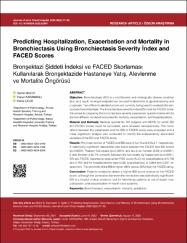| dc.contributor.author | Bulut, Sertan | |
| dc.contributor.author | Karamanlı, Harun | |
| dc.contributor.author | Çelik Deniz | |
| dc.date.accessioned | 2023-07-28T12:36:53Z | |
| dc.date.available | 2023-07-28T12:36:53Z | |
| dc.date.issued | 2022 | en_US |
| dc.identifier.uri | https://search.trdizin.gov.tr/tr/yayin/detay/1121525/predicting-hospitalization-exacerbation-and-mortality-in-bronchiectasis-using-bronchiectasis-severity-index-and-faced-scores | |
| dc.identifier.uri | https://hdl.handle.net/20.500.12868/2294 | |
| dc.description.abstract | Objective: Bronchiectasis (BC) is a multifaceted and etiologically diverse condition and, as a result, no single endpoint can be used to determine its general severity and prognosis. Two different validated scores are currently being used to evaluate the seri ousness bronchiectasis: The bronchiectasis severity index (BSI) and the FACED score. It is aimed at comparing the bronchiectasis severity assessment questionnaires whichs are two different validated outcomes for mortality, exacerbation, and hospitalizations. Material and Methods: Medical records for 107 subjects with NCFB, for which BSI and FACED scores could be calculated, were reviewed retrospectively. The corre lations between the parameters and the BSI or FACED score were evaluated and a linear regression analysis was conducted to identify the independently associated variables of the BSI and FACED score. Results: The mean scores of FACED and BSI were 3.5±1.9 and 9.8±4.7, respectively. A statistically significant relationship was found between the FACED and BSI scores (p<0.0001), Pearson Chi-square (p=0.0001), and tau-b de Kendall (0.59; p=0.0001). It was showed a 60.7% similarity between the two scales by Kappa test (p<0.0001). BSI and FACED reported an area under ROC curve (AUC) for exacerbations of 0.758 and 0.755; and for hospitalizations (due to BE exacerbations) of 0.864 and 0.597, re spectively. The sensitivity of the BSI is higher (86% versus 59%) than the FACED rating. Conclusion: Patients tended to obtain a higher BSI score relative to the FACED score, although the correlation between the two scales was statistically significant. BSI is a helpful clinical predictor tool for identifying patients at risk of death, hos pitalization, and exacerbation in health-care systems. | en_US |
| dc.language.iso | eng | en_US |
| dc.relation.isversionof | 10.14744/IGH.2022.02997 | en_US |
| dc.rights | info:eu-repo/semantics/openAccess | en_US |
| dc.subject | Bronchiectasis | en_US |
| dc.subject | Exacerbation | en_US |
| dc.subject | Mortality | en_US |
| dc.subject | Prediction | en_US |
| dc.subject | Alevlenme | en_US |
| dc.subject | Bronşektazi | en_US |
| dc.subject | Mortalite | en_US |
| dc.subject | Tahmini Değerlendirme | en_US |
| dc.title | Predicting Hospitalization, Exacerbation and Mortality in Bronchiectasis Using Bronchiectasis Severity İndex and FACED Scores | en_US |
| dc.type | article | en_US |
| dc.contributor.department | ALKÜ, Fakülteler, Tıp Fakültesi, Dahili Tıp Bilimleri Bölümü | en_US |
| dc.identifier.volume | 36 | en_US |
| dc.identifier.issue | 2 | en_US |
| dc.identifier.startpage | 77 | en_US |
| dc.identifier.endpage | 85 | en_US |
| dc.relation.journal | İzmir Göğüs Hastanesi Dergisi | en_US |
| dc.relation.publicationcategory | Makale - Uluslararası Hakemli Dergi - Kurum Öğretim Elemanı | en_US |


















